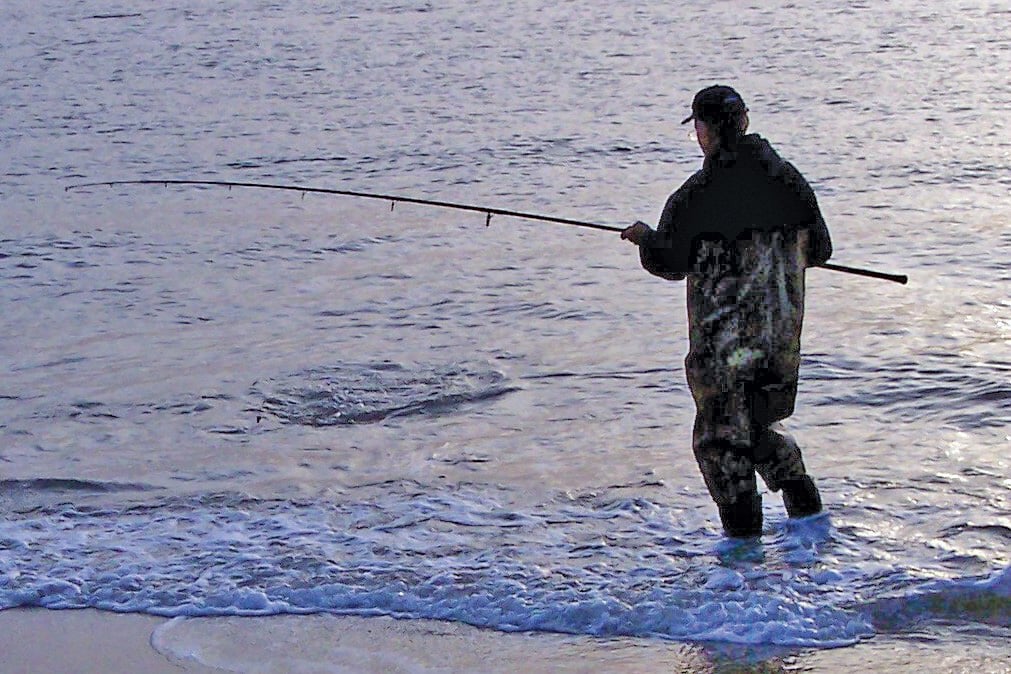
The biggest fish of the fall run typically have this one thing in common – it’s all about the bunker!
You simply cannot beat a fresh moss bunker for bait. These universally popular forage fish have different names in different locales – bunker, bugmouth, pogies – but whatever you call them, their role in the marine food chain is critical.
Their oily flesh is pure manna to striped bass, bluefish, and many other marine species. The essential nourishment that bunkers inject into the forage equation fuels the sustainability and health of all these fisheries. Measured against any standard, bunker is an elite meat.
Some anglers use the entire bunker body when they liveline for striped bass; there are occasions when surf anglers use the snag-and-drop technique, however, most surfcasters use smaller types of fresh bunker pieces when they are targeting bass and blues be it the head, belly strips, back tenderloin chunks, or traditional back-to-belly slabs.
Bunker juice can be used to refresh chunks; leftover pieces can be thrown offshore into the feeding zone as a primitive kind of chum. Nothing should be wasted – and most often isn’t. For all its attractiveness and versatility, fresh bunker is relatively inexpensive.
Bunkerin’ Basics
Any bunker you choose to use as beach bait should be fresh; avoid anything frozen or thawed. The bunker you purchase at your favorite bait shop – or which you net yourself – should be firm, slimy, and glittery. Keep in mind that you are going to be casting your morsel offshore, not dropping it down as from a boat. A big hook should hold fresh bunker pretty securely but some casters prefer using some kind of wrap – like string or a tie – to keep the bait firmly in place.
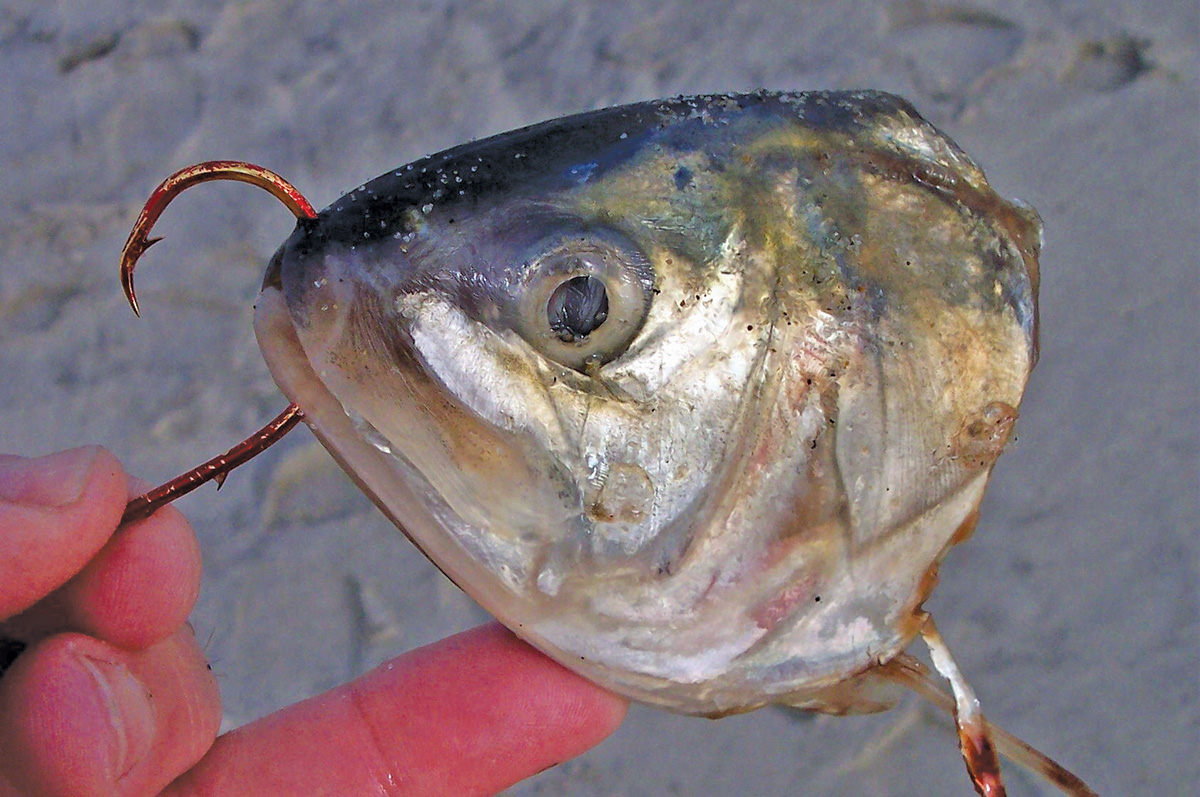
You can get four to five baits from an average-size bunker. Many bass sharpies love bunker heads, but back tenderloin chunks and the back-to-belly slabs are the most commonly used bunker baits; tails are basically useless. With whatever part of a bunker you prefer to lob seaward, be sure to keep your next baits protected so they remain cool and moist. Doing so will keep them fresh and help ensure that their scent trail will be crisp and appealing when their turn comes to hit the water.
Using fresh bunker is one part of a winning equation; your ability to present and place your baits accurately and convincingly is also critical. Never underestimate the importance of hooking your baits correctly. Always use hooks big enough so that their barbs are fully exposed. I recommend using wide-gap or circle hooks, which normally result in lip hook-ups; using J-hooks with bait too often results in deep hooking. Lip hook-ups result in lower mortality rates for released fish, which is important if you are a catch-and-release angler or if a fish you land is short.
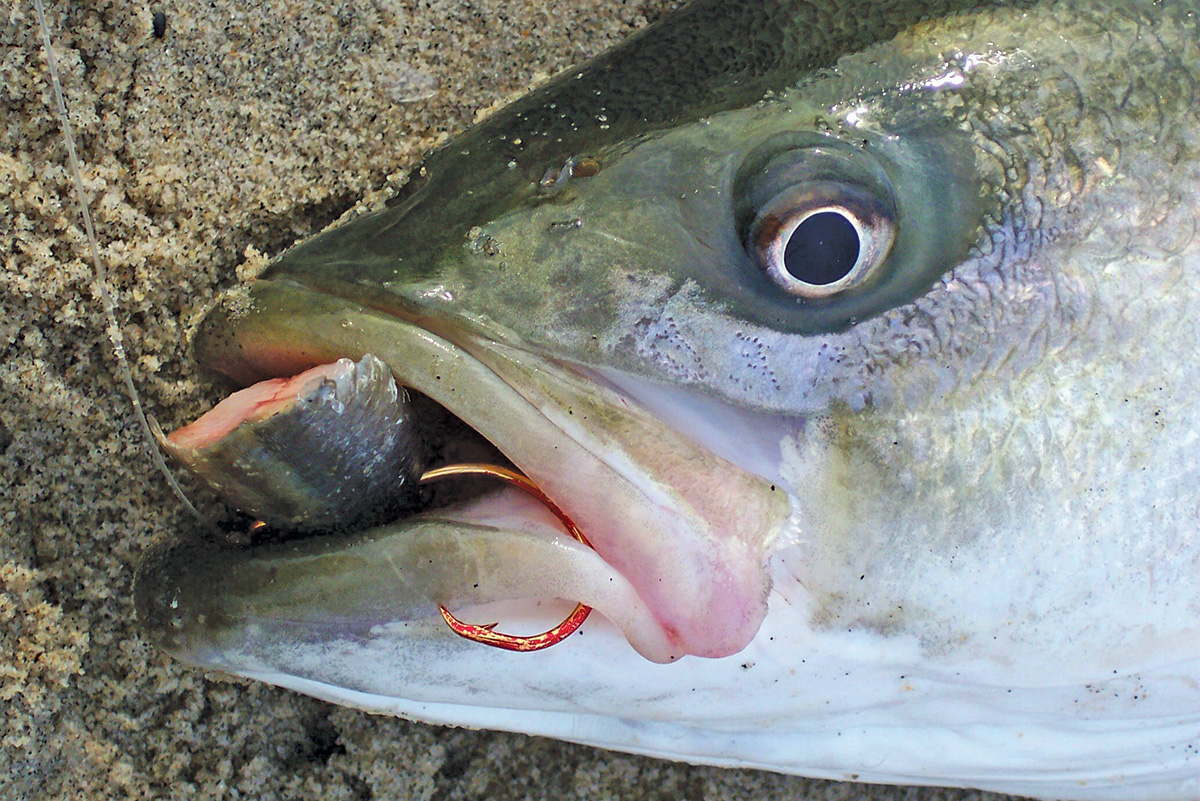
Whether you use back chunks or backto- belly slabs, place your hook in the meatiest part of your bait – in the fat back meat. There are mixed opinions about where best to place your hook in a bunker head: through the lips, the eyes, or just the meat above the head. Wherever you decide to place your hook in any part of a bunker body, remember to make sure that the hook point is exposed. Hook points that are sharpened to a razor’s edge will boost your hook-up percentages.
Riggin’ Up
Bunker rig options are many. Some anglers prefer a fish-finder rig; others favor either a single hook on a dropper loop or a double-hook hi-lo rig. I personally prefer a hi-low rig made up of a quality swivel connecting the rig to the main line, two dropper loops, and a sinker clip at the end. The swivel minimizes spin and twist in rough surf and strong currents; the two dropper loop hooks give you two chances to hook-up; the sinker clip enables you to change sinker weights and types quickly depending on sea conditions.
My first rig to hit the water has two fresh baits on it. When the baits are almost washed out, I leave one used piece on one hook and a fresh one on the other. This helps me to manage and maximize my bait supply to the utmost. When that rig is brought in, I discard the washed-out bait, keep the used bunker on one hook, and add a fresh one to the other; I repeat this process until my bait is gone. Only one new bait is used on each cast after the first presentation but two baited hooks are there for the taking.
When the surf is roiled or when the current is extremely swift, I opt for rigs with a single hook on a dropper loop. This cuts down on the rig’s drag in such conditions, allows for a more firm placement of the rig, and reduces the need for the amount of lead needed to hold bottom. Single hook float rigs are another option that I use but only rarely. Their main advantage is that they eliminate distractions from crabs, skates, and other scavengers that are bait stealers.
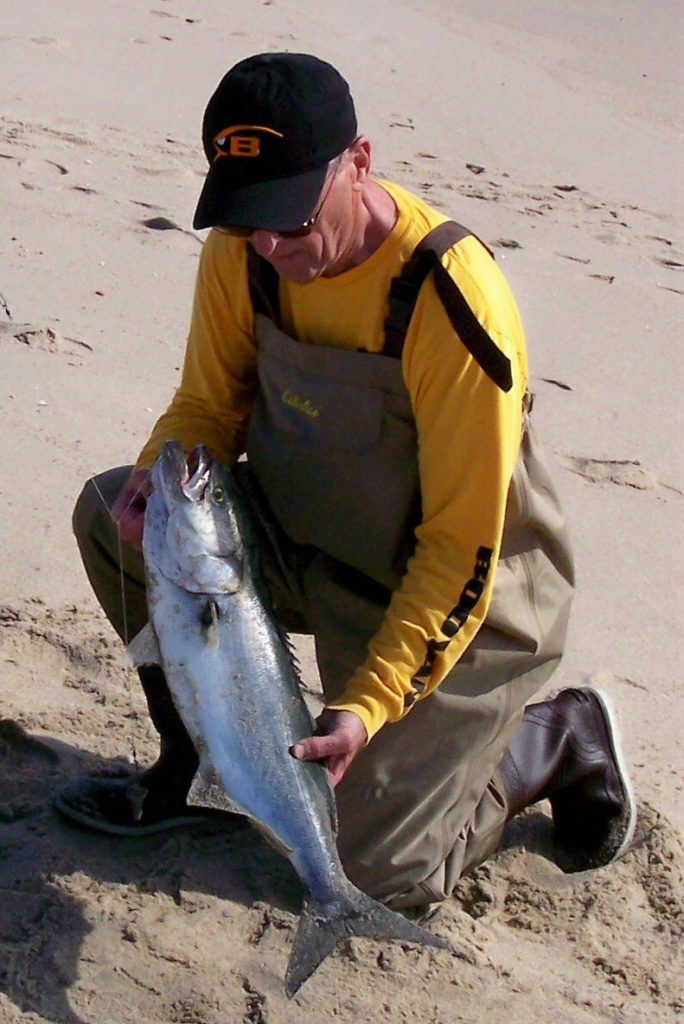
Sinkers may not be an exciting part of your presentation package but they are an essential element in proper presentation. Always use the minimum weight needed to hold bottom to maximize your chances of hooking up; bass and blues will sometimes let a bait go when they feel the resistance of a heavy sinker holding the rig back. That is the most advantageous feature of fish-finder rigs that they let a fish take the bait and run with it before feeling the weight of the sinker. My favorite baitfishing sinker type is the Hatteras, but pyramids will do the job; sputnik sinkers give absolutely the best gripping action in rough water.
I always like to use two rod/ reel combos when baitfishing: a bigger one so one rig can be positioned offshore and a shorter one that can place a bait in tight to the beach. Some days the offshore zone is hot; other days, the fish are in close. Putting rigs in both zones make sense, doubling your odds of finding the fish.
| THE SMELL TEST |
|---|
|
BioEdge makes a variety of scents extracted from a wide range of natural baits including bunker, clam, crab, bloodworm, sandworm, eel, mackerel, herring, squid, and shrimp. They’re good for refreshing washed-out baits and even enhancing fresh, unused baits. They have proven to me and others that their scents help to catch fish. BioEdge scents are available in two forms. First, their potions come in 2-ounce plastic squirt bottles that can be used to apply on live or cut bait, flies, soft plastics, and even sinkers. Soft plastics marinated in a potion slowly release their scents while being fished. The second scent option is with their wands, which resemble glue sticks in both appearance and function; they can be used to quickly and easily coat metal, bucktail or hard plastic lures – and Learn more at www.bioedgefishing.com. |
Makin’ Scents
Even though fresh bunker baits put out great scent trails, eventually they wash out, and their aroma streams are not as strong. It is a good idea to check and preferably replace bunker baits every 15 or 20 minutes or so to keep scent trails flowing – and to increase your odds of striped bass and bluefish finding your baits. Ideally, replacing washed-out baits with fresh ones is best but you can also refresh some baits and reuse them. As long as used baits still have reasonable substance to them, they can be soaked for 10 minutes or so in bunker oil sold at bait shops and reused.
Nothing should be wasted when you purchase fresh moss bunkers. The prime pieces work their magic as baits but the leftovers – the tail and guts – can also be used. The scraps and remnants can serve almost like chum if you can place them near a close-to-shore rig. Some baitfishing old-timers even use a rubber-band or tie to attach the guts to their bait rigs to create an even stronger scent flow. This may not be a mainstream technique but it works.
Another unorthodox tactic is to attach a small sponge – about the size of a dime – to the eyes of your hooks and then apply one of the new natural scents to the sponge. You might want to even experiment with putting some scent juice on your rig sinkers, or adding a small sponge to the sinker clip to which you can apply scent potion.
These may be unusual ways to put out a scent trail but if they help gamefish to find your rigs, who cares? Gamefish love fresh bunker; any enhancement of their natural attraction is just a plus.

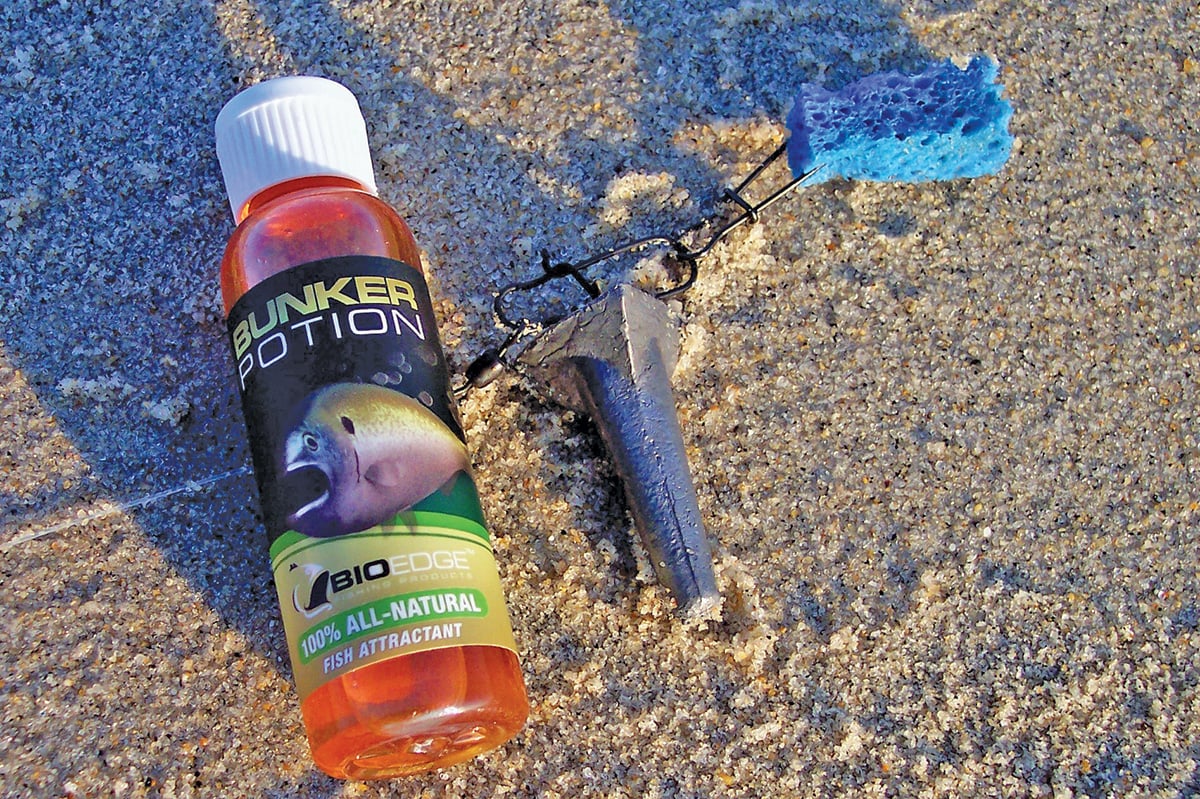 Gamefish have extraordinary eyesight and amazing scent perception: they need those assets in order to feed and to survive. Lures that look like real baitfish outperform just pieces of metal and both hard and soft plastic slabs. Live and cut bait plus assorted lures that give out strong scents mimicking scents of real forage are also going to be more successful in getting the attention of gamefish and attracting them to the point of origin.
Gamefish have extraordinary eyesight and amazing scent perception: they need those assets in order to feed and to survive. Lures that look like real baitfish outperform just pieces of metal and both hard and soft plastic slabs. Live and cut bait plus assorted lures that give out strong scents mimicking scents of real forage are also going to be more successful in getting the attention of gamefish and attracting them to the point of origin.


